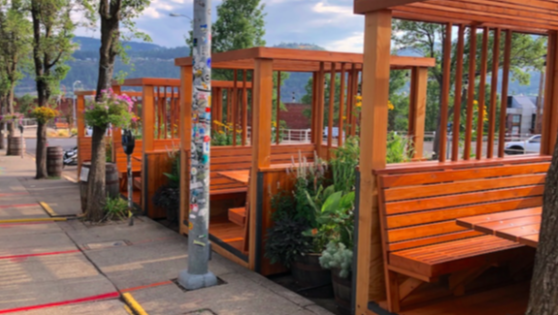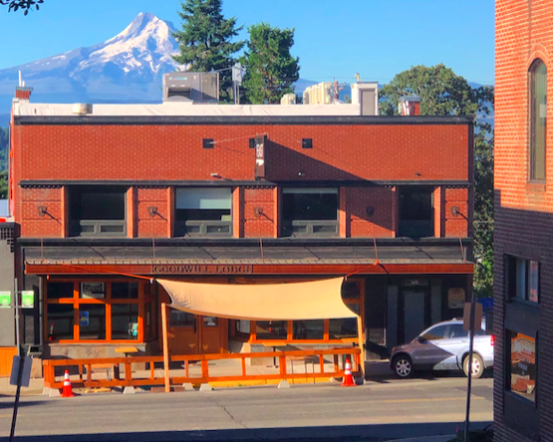 _________________________________
_________________________________


 “In towns and cities... there is no more important institution than the local paper.”
Warren Buffett
“In towns and cities... there is no more important institution than the local paper.”
Warren Buffett
By Michael Mehaffy, Ph.D., Executive Director-Suzanne C. and Henry L. Lennard Institute for Livable Cities
Hosts of the International Making Cities Livable (IMCL) conference series

Diners from two restaurants in Portland, Oregon, Zeus Cafe and Jake’s, enjoy the newly reclaimed street space next to a “bicycle boulevard”.
Since their beginnings, cities and towns have had to adapt to pandemics along with other traumatic events like wars, fires and weather disasters. On the plus side, those calamities have often spurred urban innovation: for example, the beautiful forms of London buildings resulted in part from the building codes imposed after the great fire of 1666.
COVID-19 seems destined to be no different. Already we can see a number of innovative new practices, as well as clever expansions of older trends that were already under way. Here are a few of note:
Streets as living rooms. Restaurants, bars and other venues are finding new ways to provide social distancing by colonizing under-utilized rights of way (like the example in Portland above). Patrons and citizens are finding these new “open street” spaces delightfully appealing, and many motorists are adapting to the restricted flow by taking new routes, or by shifting their own travel to bikes or walking. While some of the spaces may revert back, given their new popularity, many are likely to be permanent.

Double Mountain Brewery and Taproom in Hood River, Oregon
A surge of parklets. A more modest accommodation to social-distance dining, these attractive replacements of under-utilized parallel parking stalls were already beginning to appear on streets in many cities. In the wake of COVID-19, they’re becoming increasingly popular. In the wintertime, they can be enclosed with tent materials and heated individually, like the booths at Double Mountain Brewery and Taproom in Hood River, Oregon (right).
Bikes are us. The popularity of bicycling is surging, as are sales of new and used bikes. This trend is prompting innovations in bike design and construction, and also resulting in new bike pathways, often taking the form of “bike boulevards.” In the US, Oakland, California, has converted 74 miles of streets to bike and pedestrian only; New York is planning to convert 100 miles, Seattle will convert 20 miles, and Boston, Minneapolis, Burlington, Philadelphia and San Francisco have also made significant conversions. In addition to bikes, e-scooters are also seeing a surge.

White Salmon, Washington
New life for old small downtowns. Walkable towns located away from over-heated (and congested) urban cores are getting a new lease on life, since employees can now telecommute from there more easily. That has benefits for the urban cores too, reducing the upward pressure on housing costs and easing forced displacement. In some cases these towns are well-connected by rail, as is the case in White Salmon, Washington (left), served by an Amtrak station just down the road. This trend could support a more “polycentric” urban form, instead of the tendency of a “monocentric” city form to promote higher prices and longer daily commutes from bedroom suburbs to central offices.
New life for old (and not so old) buildings. As the market dramatically shifts away from centralized offices and corporate office parks, adaptive reuse is getting new attention. Developers are looking at adding residential and other mixed uses to these structures, accelerating a trend that has been under way for a number of years, and changing the landscape of urban and suburban single-use zones.
It’s worth emphasizing that these new practices are not uniformly positive. Like any innovation, they have to be adapted to specific contexts, working out the issues involved with stakeholders. And it’s important to share and apply lessons about what works well and doesn’t, and why. That’s one reason that the IMCL conferences bring together innovators from many different places to share their successes and lessons. And it’s one reason that the conference next June will be especially meaningful, as we assess these and other urban innovations, and other lessons from the pandemic.
We will examine some truly alarming new trends as well. The increasing retreat to encapsulated, drive-through lifestyles is particularly worrisome, with potential negative impacts on public health, social interaction, social capital, urban resilience, and of course, resource use — as we have written about before. The increased opportunity to work from home, while providing greater flexibility in lifestyle, could also fuel the already worrisome trends of social isolation, loneliness, and declining social capital.
As with all pandemics — and all forms of urban adaptation — the outcome is not pre-determined: we have choices to make, as individuals, as professionals, and as citizens. We look forward to lively discussions in June!